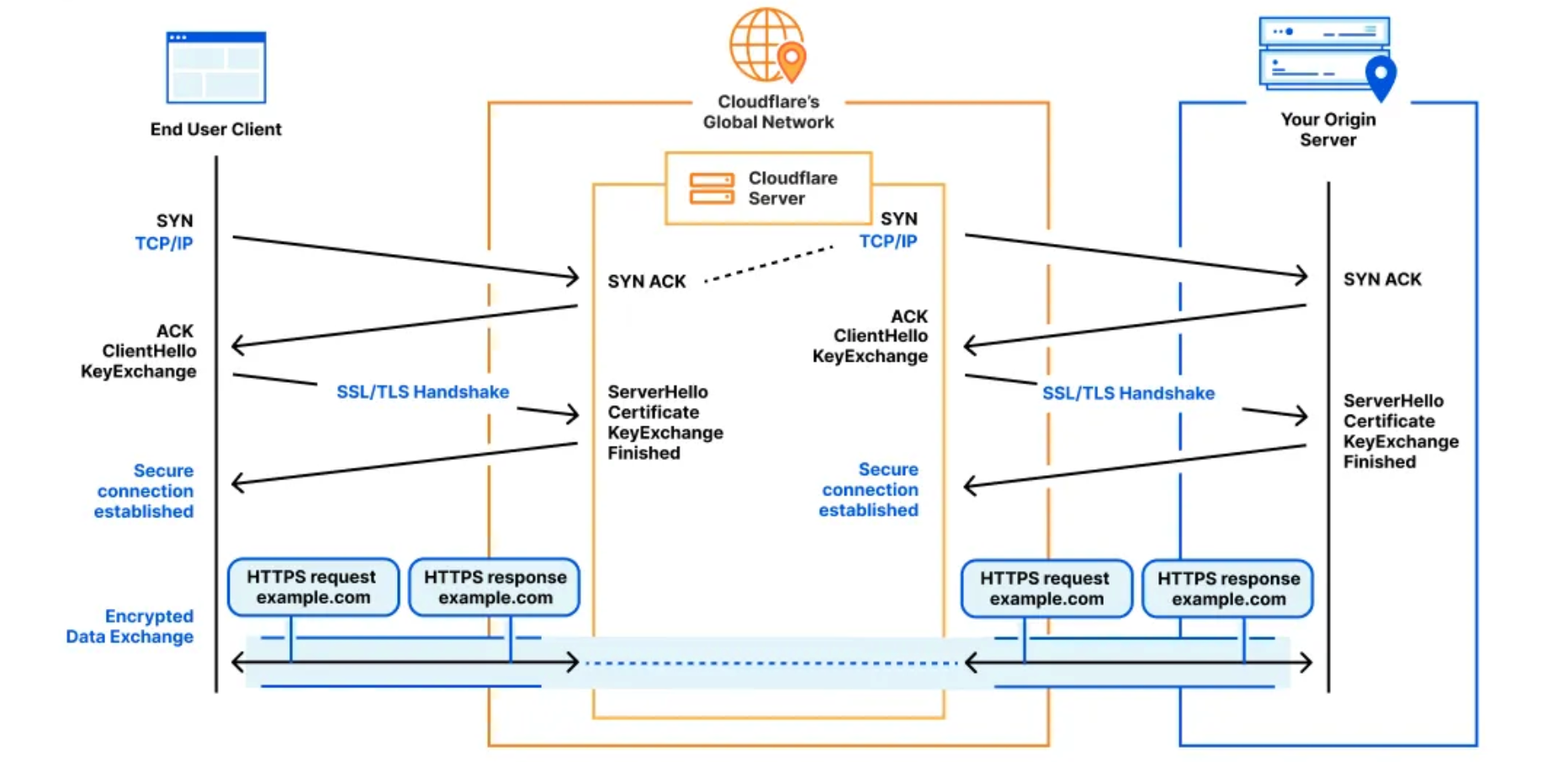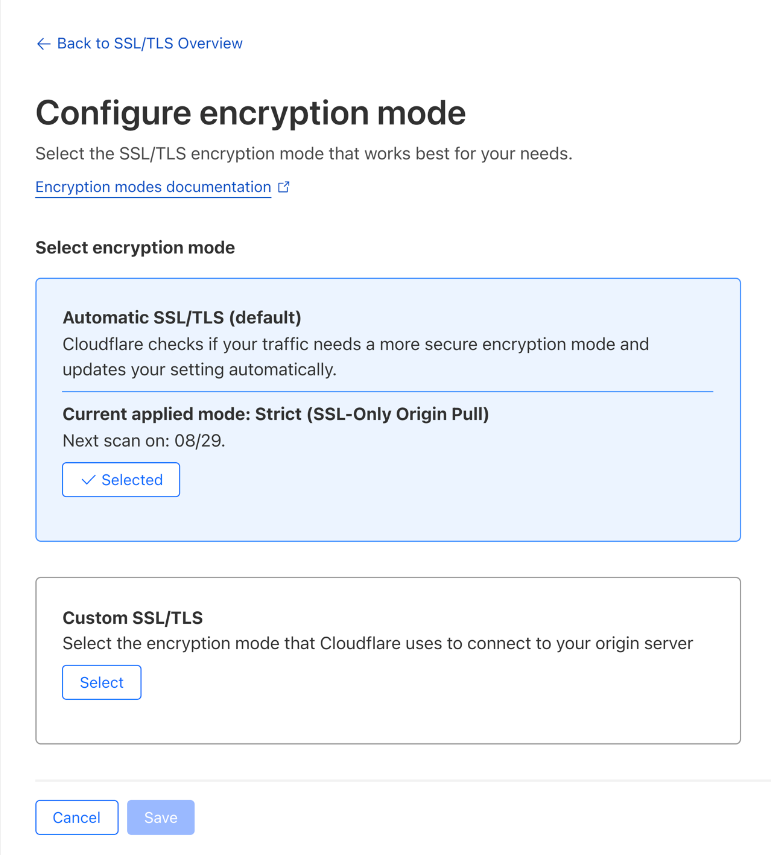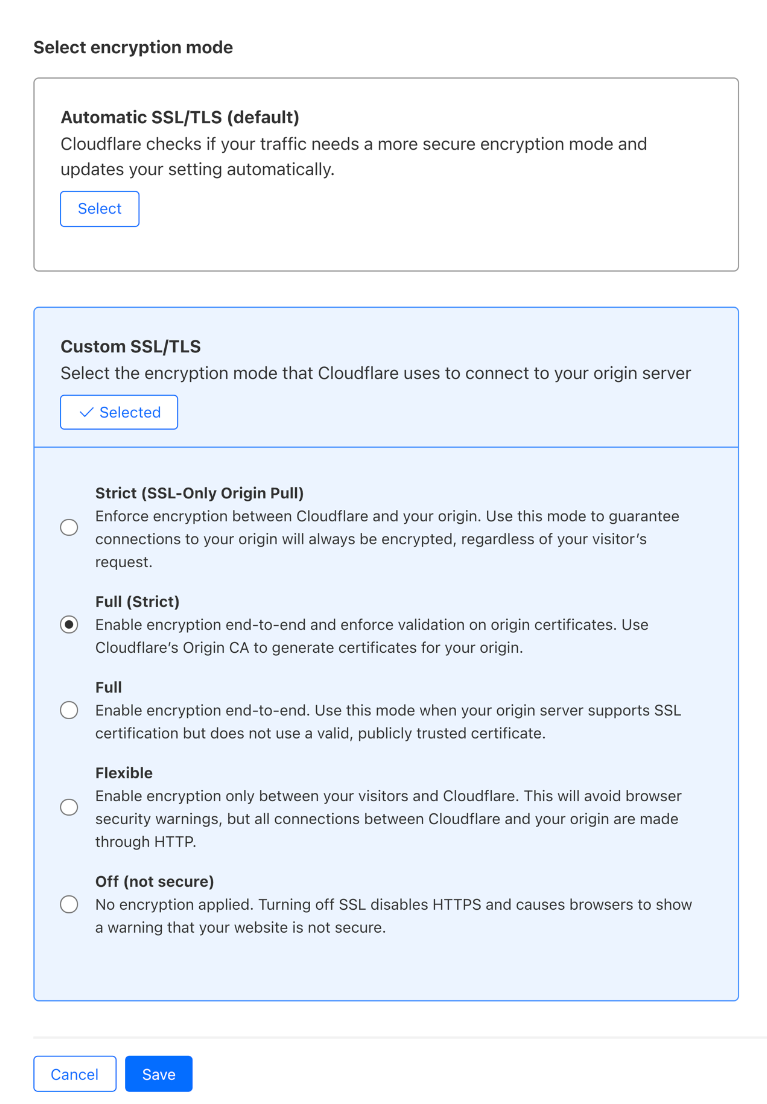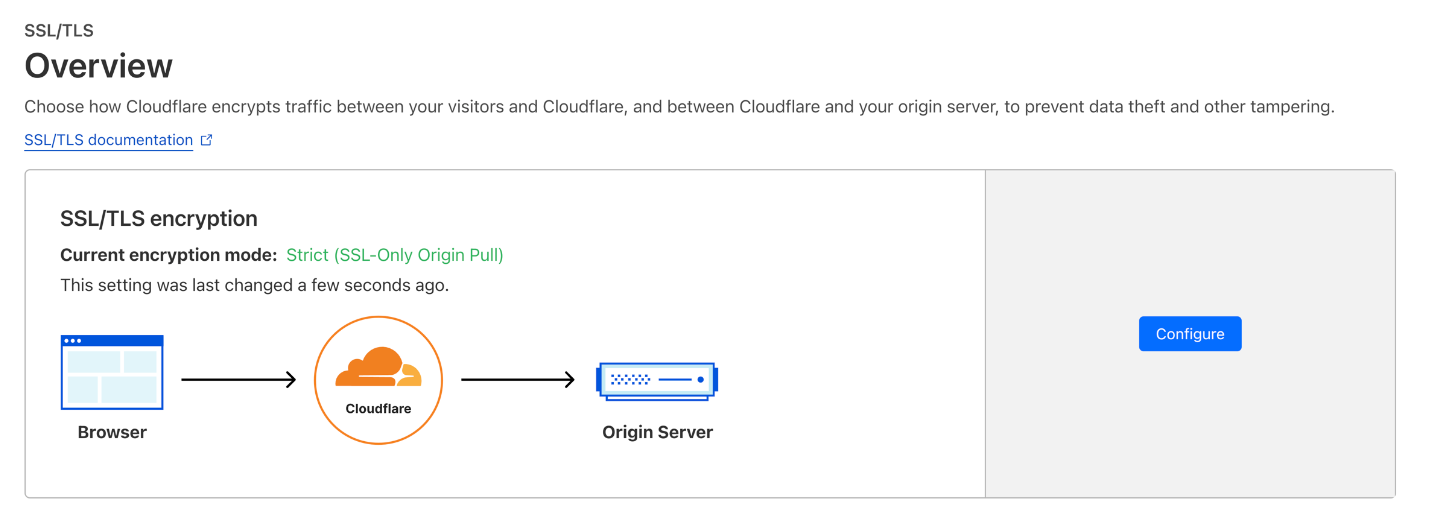2024-08-08
11 min read

During Birthday Week 2022, we pledged to provide our customers with the most secure connection possible from Cloudflare to their origin servers automatically. I’m thrilled to announce we will begin rolling this experience out to customers who have the SSL/TLS Recommender enabled on August 8, 2024. Following this, remaining Free and Pro customers can use this feature beginning September 16, 2024, with Business and Enterprise customers to follow.
Although it took longer than anticipated to roll out, our priority was to achieve an automatic configuration both transparently and without risking any site downtime. Taking this additional time allowed us to balance enhanced security with seamless site functionality, especially since origin server security configuration and capabilities are beyond Cloudflare's direct control. The new Automatic SSL/TLS setting will maximize and simplify the encryption modes Cloudflare uses to communicate with origin servers by using the SSL/TLS Recommender.

We first talked about this process in 2014: at that time, securing connections was hard to configure, prohibitively expensive, and required specialized knowledge to set up correctly. To help alleviate these pains, Cloudflare introduced Universal SSL, which allowed web properties to obtain a free SSL/TLS certificate to enhance the security of connections between browsers and Cloudflare.
This worked well and was easy because Cloudflare could manage the certificates and connection security from incoming browsers. As a result of that work, the number of encrypted HTTPS connections on the entire Internet doubled at that time. However, the connections made from Cloudflare to origin servers still required manual configuration of the encryption modes to let Cloudflare know the capabilities of the origin.
Today we’re excited to begin the sequel to Universal SSL and make security between Cloudflare and origins automatic and easy for everyone.
History of securing origin-facing connections
Ensuring that more bytes flowing across the Internet are automatically encrypted strengthens the barrier against interception, throttling, and censorship of Internet traffic by third parties.
Generally, two communicating parties (often a client and server) establish a secure connection using the TLS protocol. For a simplified breakdown:
- The client advertises the list of encryption parameters it supports (along with some metadata) to the server.
- The server responds back with its own preference of the chosen encryption parameters. It also sends a digital certificate so that the client can authenticate its identity.
- The client validates the server identity, confirming that the server is who it says it is.
- Both sides agree on a symmetric secret key for the session that is used to encrypt and decrypt all transmitted content over the connection.
Because Cloudflare acts as an intermediary between the client and our customer’s origin server, two separate TLS connections are established. One between the user’s browser and our network, and the other from our network to the origin server. This allows us to manage and optimize the security and performance of both connections independently.

Unlike securing connections between clients and Cloudflare, the security capabilities of origin servers are not under our direct control. For example, we can manage the certificate (the file used to verify identity and provide context on establishing encrypted connections) between clients and Cloudflare because it’s our job in that connection to provide it to clients, but when talking to origin servers, Cloudflare is the client.
Customers need to acquire and provision an origin certificate on their host. They then have to configure Cloudflare to expect the new certificate from the origin when opening a connection. Needing to manually configure connection security across multiple different places requires effort and is prone to human error.
This issue was discussed in the original Universal SSL blog:
For a site that did not have SSL before, we will default to our Flexible SSL mode, which means traffic from browsers to Cloudflare will be encrypted, but traffic from Cloudflare to a site's origin server will not. We strongly recommend site owners install a certificate on their web servers so we can encrypt traffic to the origin … Once you've installed a certificate on your web server, you can enable the Full or Strict SSL modes which encrypt origin traffic and provide a higher level of security.
Over the years Cloudflare has introduced numerous products to help customers configure how Cloudflare should talk to their origin. These products include a certificate authority to help customers obtain a certificate to verify their origin server’s identity and encryption capabilities, Authenticated Origin Pulls that ensures only HTTPS (encrypted) requests from Cloudflare will receive a response from the origin server, and Cloudflare Tunnels that can be configured to proactively establish secure and private tunnels to the nearest Cloudflare data center. Additionally, the ACME protocol and its corresponding Certbot tooling make it easier than ever to obtain and manage publicly-trusted certificates on customer origins. While these technologies help customers configure how Cloudflare should communicate with their origin server, they still require manual configuration changes on the origin and to Cloudflare settings.
Ensuring certificates are configured appropriately on origin servers and informing Cloudflare about how we should communicate with origins can be anxiety-inducing because misconfiguration can lead to downtime if something isn’t deployed or configured correctly.
To simplify this process and help identify the most secure options that customers could be using without any misconfiguration risk, Cloudflare introduced the SSL/TLS Recommender in 2021. The Recommender works by probing customer origins with different SSL/TLS settings to provide a recommendation whether the SSL/TLS encryption mode for the web property can be improved. The Recommender has been in production for three years and has consistently managed to provide high quality origin-security recommendations for Cloudflare’s customers.
The SSL/TLS Recommender system serves as the brain of the automatic origin connection service that we are announcing today.
How does SSL/TLS Recommendation work?
The Recommender works by actively comparing content on web pages that have been downloaded using different SSL/TLS modes to see if it is safe and risk-free to update the mode Cloudflare uses to connect to origin servers.
Cloudflare currently offers five SSL/TLS modes:
- Off: No encryption is used for traffic between browsers and Cloudflare or between Cloudflare and origins. Everything is cleartext HTTP.
- Flexible: Traffic from browsers to Cloudflare can be encrypted via HTTPS, but traffic from Cloudflare to the origin server is not. This mode is common for origins that do not support TLS, though upgrading the origin configuration is recommended whenever possible. A guide for upgrading is available here.
- Full: Cloudflare matches the browser request protocol when connecting to the origin. If the browser uses HTTP, Cloudflare connects to the origin via HTTP; if HTTPS, Cloudflare uses HTTPS without validating the origin’s certificate. This mode is common for origins that use self-signed or otherwise invalid certificates.
- Full (Strict): Similar to Full Mode, but with added validation of the origin server’s certificate, which can be issued by a public CA like Let’s Encrypt or by Cloudflare Origin CA.
- Strict (SSL-only origin pull): Regardless of whether the browser-to-Cloudflare connection uses HTTP or HTTPS, Cloudflare always connects to the origin over HTTPS with certificate validation.
HTTP from visitor | HTTPS from visitor | |
Off | HTTP to origin | HTTP to origin |
Flexible | HTTP to origin | HTTP to origin |
Full | HTTP to origin | HTTPS without cert validation to origin |
Full (strict) | HTTP to origin | HTTPS with cert validation to origin |
Strict (SSL-only origin pull) | HTTPS with cert validation to origin | HTTPS with cert validation to origin |
The SSL/TLS Recommender works by crawling customer sites and collecting links on the page (like any web crawler). The Recommender downloads content over both HTTP and HTTPS, making GET requests to avoid modifying server resources. It then uses a content similarity algorithm, adapted from the research paper "A Deeper Look at Web Content Availability and Consistency over HTTP/S" (TMA Conference 2020), to determine if content matches. If the content does match, the Recommender makes a determination for whether the SSL/TLS mode can be increased without misconfiguration risk.
The recommendations are currently delivered to customers via email.
When the Recommender is making security recommendations, it errs on the side of maintaining current site functionality to avoid breakage and usability issues. If a website is non-functional, blocks all bots, or has SSL/TLS-specific Page Rules or Configuration Rules, the Recommender may not complete its scans and provide a recommendation. It was designed to maximize domain security, but will not help resolve website or domain functionality issues.
The crawler uses the user agent "Cloudflare-SSLDetector" and is included in Cloudflare’s list of known good bots. It ignores robots.txt (except for rules specifically targeting its user agent) to ensure accurate recommendations.
When downloading content from your origin server over both HTTP and HTTPS and comparing the content, the Recommender understands the current SSL/TLS encryption mode that your website uses and what risk there might be to the site functionality if the recommendation is followed.
Using SSL/TLS Recommender to automatically manage SSL/TLS settings
Previously, signing up for the SSL/TLS Recommender provided a good experience for customers, but only resulted in an email recommendation in the event that a zone’s current SSL/TLS modes could be updated. To Cloudflare, this was a positive signal that customers wanted their websites to have more secure connections to their origin servers – over 2 million domains have enabled the SSL/TLS Recommender. However, we found that a significant number of users would not complete the next step of pushing the button to inform Cloudflare that we could communicate over the upgraded settings. Only 30% of the recommendations that the system provided were followed.
With the system designed to increase security while avoiding any breaking changes, we wanted to provide an option for customers to allow the Recommender to help upgrade their site security, without requiring further manual action from the customer. Therefore, we are introducing a new option for managing SSL/TLS configuration on Cloudflare: Automatic SSL/TLS.

Automatic SSL/TLS uses the SSL/TLS Recommender to make the determination as to what encryption mode is the most secure and safest for a website to be set to. If there is a more secure option for your website (based on your origin certification or capabilities), Automatic SSL/TLS will find it and apply it for your domain. The other option, Custom SSL/TLS, will work exactly like the setting the encryption mode does today. If you know what setting you want, just select it using Custom SSL/TLS, and we’ll use it.

Automatic SSL/TLS is currently meant to service an entire website, which typically works well for those with a single origin. For those concerned that they have more complex setups which use multiple origin servers with different security capabilities, don’t worry. Automatic SSL/TLS will still avoid breaking site functionality by looking for the best setting that works for all origins serving a part of the site’s traffic.
If customers want to segment the SSL/TLS mode used to communicate with the numerous origins that service their domain, they can achieve this by using Configuration Rules. These rules allow you to set more precise modes that Cloudflare should respect (based on path or subdomain or even IP address) to maximize the security of the domain based on your desired Rules criteria. If your site uses SSL/TLS-specific settings in a Configuration Rule or Page rule, those settings will override the zone-wide Automatic and Custom settings.

The goal of Automatic SSL/TLS is to simplify and maximize the origin-facing security for customers on Cloudflare. We want this to be the new default for all websites on Cloudflare, but we understand that not everyone wants this new default, and we will respect your decision for how Cloudflare should communicate with your origin server. If you block the Recommender from completing its crawls, the origin server is non-functional or can’t be crawled, or if you want to opt out of this default and just continue using the same encryption mode you are using today, we will make it easy for you to tell us what you prefer.
How to onboard to Automatic SSL/TLS
To improve the security settings for everyone by default, we are making the following default changes to how Cloudflare configures the SSL/TLS level for all zones:
Starting on August 8, 2024, websites with the SSL/TLS Recommender currently enabled will have the Automatic SSL/TLS setting enabled by default. Enabling does not mean that the Recommender will begin scanning and applying new settings immediately though. There will be a one-month grace period before the first scans begin and the recommended settings are applied. Enterprise (ENT) customers will get a six-week grace period. Origin scans will start getting scheduled by September 9, 2024, for non-Enterprise customers and September 23rd for ENT customers with the SSL Recommender enabled. This will give customers the ability to opt out by removing Automatic SSL/TLS and selecting the Custom mode that they want to use instead.
Further, during the second week of September all new zones signing up for Cloudflare will start seeing the Automatic SSL/TLS setting enabled by default.
Beginning September 16, 2024, remaining Free and Pro customers will start to see the new Automatic SSL/TLS setting. They will also have a one-month grace period to opt out before the scans start taking effect.
Customers in the cohort having the new Automatic SSL/TLS setting applied will receive an email communication regarding the date that they are slated for this migration as well as a banner on the dashboard that mentions this transition as well. If they do not wish for Cloudflare to change anything in their configurations, the process for opt-out of this migration is outlined below.
Following the successful migration of Free and Pro customers, we will proceed to Business and Enterprise customers with a similar cadence. These customers will get email notifications and information in the dashboard when they are in the migration cohort.
The Automatic SSL/TLS setting will not impact users that are already in Strict or Full (strict) mode nor will it impact websites that have opted-out.
Opting out
There are a number of reasons why someone might want to configure a lower-than-optimal security setting for their website. Some may want to set a lower security setting for testing purposes or to debug some behavior. Whatever the reason, the options to opt-out of the Automatic SSL/TLS setting during the migration process are available in the dashboard and API.
To opt-out, simply select Custom SSL/TLS in the dashboard (instead of the enabled Automatic SSL/TLS) and we will continue to use the previously set encryption mode that you were using prior to the migration. Automatic and Custom SSL/TLS modes can be found in the Overview tab of the SSL/TLS section of the dashboard. To enable your preferred mode, select configure.

If you want to opt out via the API you can make this API call on or before the grace period expiration date.
curl --request PATCH \
--url https://api.cloudflare.com/client/v4/zones/<insert_zone_tag_here>/settings/ssl_automatic_mode \
--header 'Authorization: Bearer <insert_api_token_here>' \
--header 'Content-Type: application/json' \
--data '{"value":"custom"}'
If an opt-out is triggered, there will not be a change to the currently configured SSL/TLS setting. You are also able to change the security level at any time by going to the SSL/TLS section of the dashboard and choosing the Custom setting you want (similar to how this is accomplished today).
If at a later point you’d like to opt in to Automatic SSL/TLS, that option is available by changing your setting from Custom to Automatic.
What if I want to be more secure now?
We will begin to roll out this change to customers with the SSL/TLS Recommender enabled on August 8, 2024. If you want to enroll in that group, we recommend enabling the Recommender as soon as possible.
If you read this and want to make sure you’re at the highest level of backend security already, we recommend Full (strict) or Strict mode. Directions on how to make sure you’re correctly configured in either of those settings are available here and here.
If you prefer to wait for us to automatically upgrade your connection to the maximum encryption mode your origin supports, please watch your inbox for the date we will begin rolling out this change for you.
Cloudflare's connectivity cloud protects entire corporate networks, helps customers build Internet-scale applications efficiently, accelerates any website or Internet application, wards off DDoS attacks, keeps hackers at bay, and can help you on your journey to Zero Trust.
Visit 1.1.1.1 from any device to get started with our free app that makes your Internet faster and safer.
To learn more about our mission to help build a better Internet, start here. If you're looking for a new career direction, check out our open positions.
